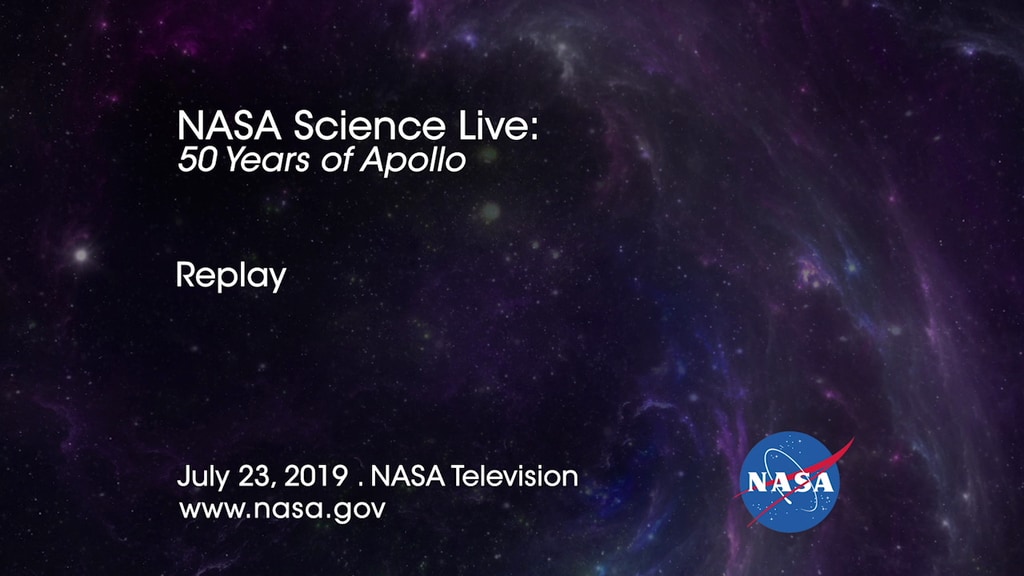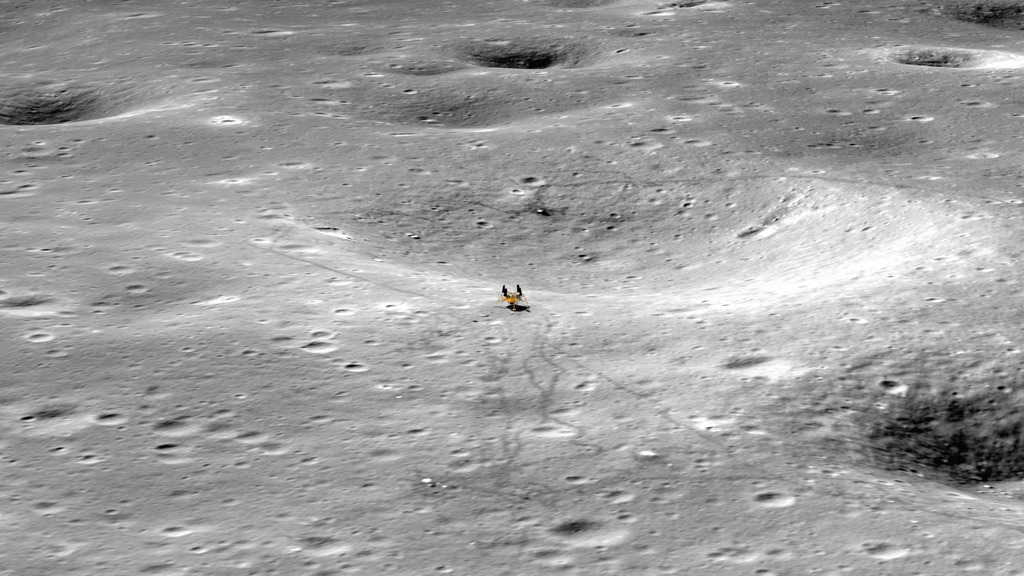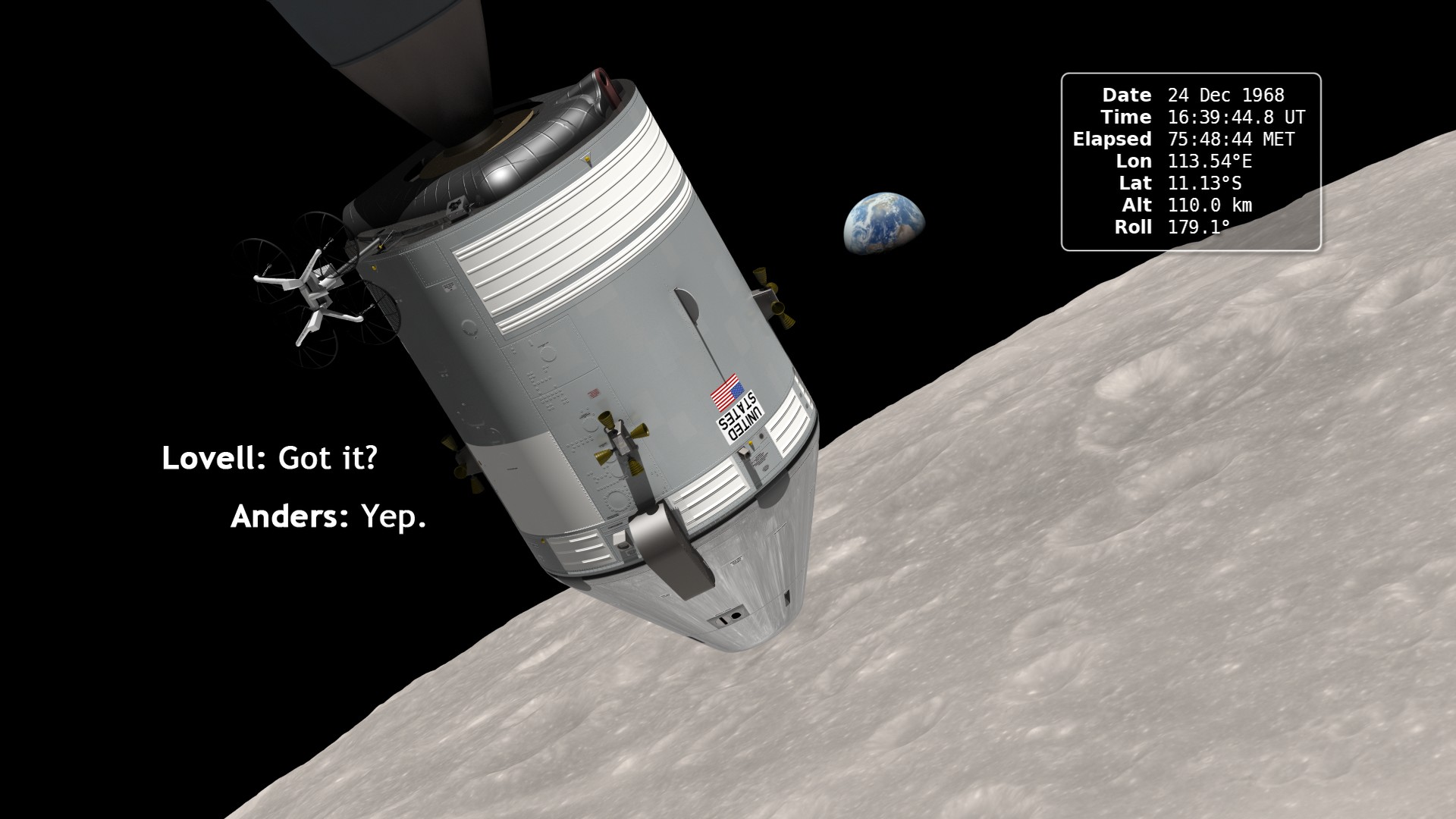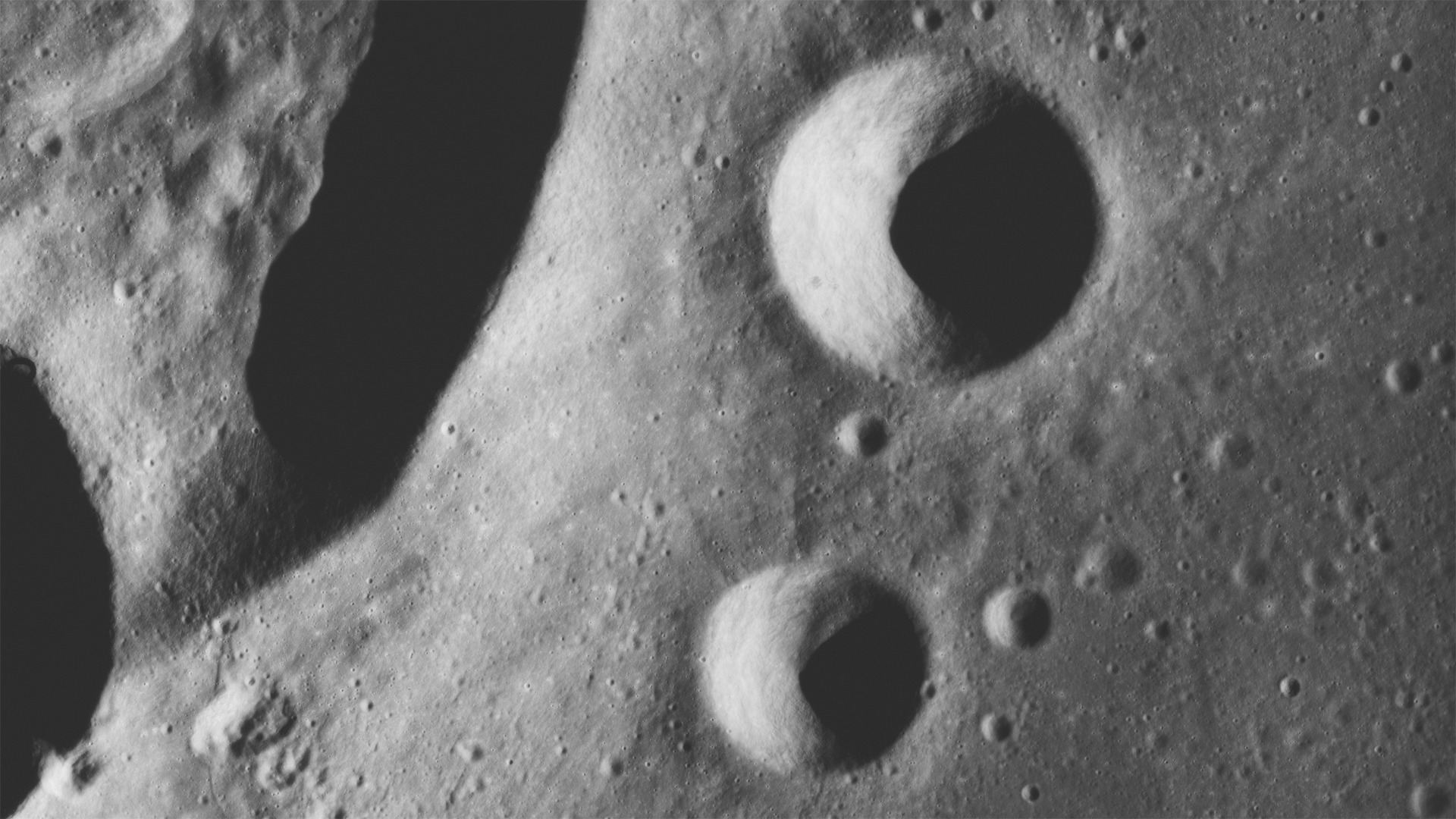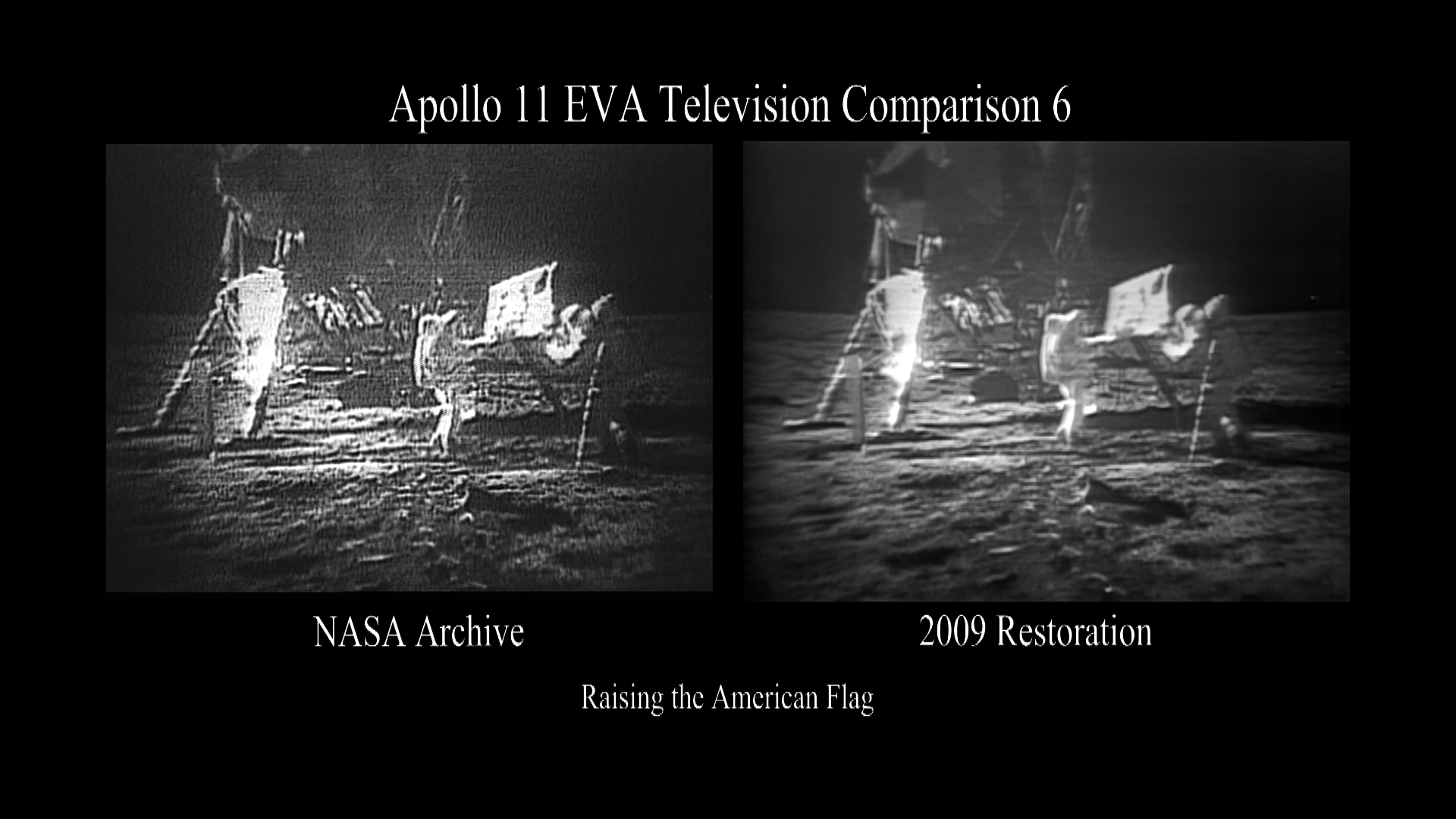Project Apollo
Overview
This is a collection of the media resources available on the Scientific Visualization Studio website relating to NASA's Apollo missions to the Moon. More information and media can be found at
- NASA.gov
- Apollo Lunar Surface Journal
- Apollo Flight Journal
- Apollo Landing Sites photographed by Lunar Reconnaissance Orbiter
- Apollo in Real Time
- Project Apollo Archive on Flickr
Stories
NASA Explorers | Season Two: Apollo
Go to this pageNASA Explorers: Apollo is an audio series that tells stories of the Moon and the people who explore it. Coming soon, you can listen to NASA Explorers: Apollo on: Apple Podcasts, SoundCloud, Google Play and Facebook Watch. Music: Tycho's Daydream by Daniel WyantisComplete transcript available. || ApolloYoutubeThumbnail_061019_1.png (1920x1080) [3.0 MB] || ApolloTrailer061019.00045_print.jpg (1024x768) [83.4 KB] || BlankBannerApollo_4.png (4334x1334) [4.1 MB] || ApolloTrailer061019.00045_searchweb.png (320x180) [66.9 KB] || ApolloTrailer061019.00045_web.png (320x240) [89.8 KB] || ApolloTrailer061019.00045_thm.png (80x40) [6.5 KB] || ApolloTrailer061019.mp4 (1440x1080) [113.7 MB] || ApolloTrailer061019.webm (1440x1080) [12.5 MB] || TrailerNASAExplorersApollo.en_US.srt [1.7 KB] || TrailerNASAExplorersApollo.en_US.vtt [1.6 KB] ||
Jack Schmitt: From Apollo 17 to LRO
Go to this pageDecember 11, 2022 will mark the 50th anniversary of the day NASA's Apollo 17 mission landed on the Moon. This video connects that history to the current Lunar Reconnaissance Orbiter mission through the eyes of astronaut Harrison Jack Schmitt. As a geologist and Apollo 17 crewmember, Schmitt has a unique perspective about how data being collected by LRO enhances our current understanding of lunar science and lays the groundwork for future explorers. ||
Apollo 13 Views of the Moon in 4K
Go to this pageThis video uses data gathered from the Lunar Reconnaissance Orbiter spacecraft to recreate some of the stunning views of the Moon that the Apollo 13 astronauts saw on their journey in 1970.Music provided by Universal Production Music: "Visions of Grandeur" - Frederick WiedmannWatch this video on the NASA Goddard YouTube channel. || Apollo13VizImage_print.jpg (1024x576) [155.7 KB] || Apollo13VizImage_searchweb.png (320x180) [101.5 KB] || Apollo13VizImage_thm.png (80x40) [7.1 KB] || 13537_Apollo13ViewsMoon4K_HDversion.mp4 (1920x1080) [315.3 MB] || 13537_Apollo13ViewsMoon4K_HDversion.webm (1920x1080) [18.8 MB] || 13537_Apollo13ViewsMoon4K_YouTube4K.mp4 (3840x2160) [682.4 MB] || 13537_Apollo13ViewsMoon4K_Facebook4K.mp4 (3840x2160) [462.8 MB] || 13537_Apollo13ViewsMoon4K_MASTER.mov (3840x2160) [6.9 GB] || 13537_Apollo13ViewsMoon4K_Captions.en_US.srt [44 bytes] || 13537_Apollo13ViewsMoon4K_Captions.en_US.vtt [57 bytes] || Apollo13VizImage.tif (3840x2160) [31.7 MB] ||
The Best Gift of All: A Box of Moon Soil
Go to this pageJamie Elsila and Danielle Simkus prepare previously unopened Apollo 17 Moon samples for analysis. Music is "Fairy Christmas" from Universal Production Music. || 13513_THUMBNAIL.jpg (1920x1080) [672.4 KB] || 13513_ApolloSampleGift_MASTER.00576_searchweb.png (320x180) [91.6 KB] || 13513_ApolloSampleGift_MASTER.00576_thm.png (80x40) [7.1 KB] || 13513_ApolloSampleGift_MASTER.mov (1920x1080) [1.1 GB] || 13513_ApolloSampleGift_MASTER_facebook_720.mp4 (1280x720) [115.9 MB] || 13513_ApolloSampleGift_MASTER_twitter_720.mp4 (1280x720) [20.1 MB] || 13513_ApolloSampleGift_MASTER.webm (960x540) [38.3 MB] || 13513_Apollo.en_US.srt [772 bytes] || 13513_Apollo.en_US.vtt [788 bytes] ||
Apollo Moon Soil Radiation Experiment
Go to this pageProfile of the Radiation Effects Laboratory at the Goddard Space Flight Center in Greenbelt, Maryland. Song: "Gateway Identified" from Universal Production Music. Watch this video on the NASA Goddard YouTube channel. || 13315_New_Thumb_print.jpg (1024x576) [125.3 KB] || 13315_New_Thumb.jpg (3840x2160) [573.4 KB] || 13315_New_Thumb_searchweb.png (320x180) [100.3 KB] || 13315_New_Thumb_thm.png (80x40) [7.6 KB] || FACEBOOK_720_13315_Apollo_Sample_MASTER_facebook_720.mp4 (1280x720) [128.2 MB] || TWITTER_720_13315_Apollo_Sample_MASTER_twitter_720.mp4 (1280x720) [22.0 MB] || 13315_Apollo_Sample_MASTER.webm (960x540) [34.5 MB] || 13315_Apollo_Sample_MASTER.mov (3840x2160) [7.4 GB] || YOUTUBE_4K_13315_Apollo_Sample_MASTER_youtube_4k.mp4 (3840x2160) [717.7 MB] || 13315_Apollo_Sample_MASTER_Output.en_US.srt [44 bytes] || 13315_Apollo_Sample_MASTER_Output.en_US.vtt [57 bytes] ||
NASA Science Live: 50 Years of Apollo (Episode 7)
Go to this pageNASA Science Live: 50 Years of Apollo (Episode 07)Program Aired July 23, 2019 || 13255_NSL_Apollo50_Ep7.00010_print.jpg (1024x576) [85.1 KB] || 13255_NSL_Apollo50_Ep7.00010_searchweb.png (320x180) [81.4 KB] || 13255_NSL_Apollo50_Ep7.00010_thm.png (80x40) [5.6 KB] || 13255_NSL_Apollo50_Ep7.mp4 (1280x720) [1.1 GB] || 13255_NSL_Apollo50_Ep7_youtube_720.mp4 (1280x720) [6.3 GB] || 13255_NSL_Apollo50_Ep7.mov (1280x720) [42.6 GB] || 13255_NSL_Apollo50_Ep7.webm (1280x720) [457.9 MB] || 13255_NSL_Apollo50_Ep7.en_US.srt [119.0 KB] || 13255_NSL_Apollo50_Ep7.en_US.vtt [112.4 KB] ||
Apollo 11: This Is Goddard
Go to this pageOn July 24, 1969, the Apollo 11 mission concluded with a splashdown in the Pacific Ocean. This 1969 documentary showcases how NASA's Goddard Space Flight Center in Greenbelt, Maryland, supported the historic mission.Complete transcript available. || Apollo11.00001_print.jpg (1024x576) [11.4 KB] || Apollo11.00001_searchweb.png (320x180) [4.8 KB] || Apollo11.00001_web.png (320x180) [4.8 KB] || Apollo11.00001_thm.png (80x40) [883 bytes] || Apollo11.mp4 (1920x1080) [2.2 GB] || Apollo11.webm (1920x1080) [154.4 MB] || Apollo11.en_US.srt [22.6 KB] || Apollo11.en_US.vtt [21.5 KB] ||
Landing Sites
- Visualization
- Visualization
- Visualization
- Visualization
- Visualization
- Visualization
- Visualization
- Visualization
- Visualization
- Visualization
- Visualization
Apollo Photos and Movies
Earthrise: The 45th Anniversary
Go to this pageIn December of 1968, the crew of Apollo 8 became the first people to leave our home planet and travel to another body in space. But as crew members Frank Borman, James Lovell, and William Anders all later recalled, the most important thing they discovered was Earth.Using photo mosaics and elevation data from Lunar Reconnaissance Orbiter (LRO), this video commemorates the 45th anniversary of Apollo 8's historic flight by recreating the moment when the crew first saw and photographed the Earth rising from behind the Moon. Narrator Andrew Chaikin, author of A Man on the Moon, sets the scene for a three-minute visualization of the view from both inside and outside the spacecraft accompanied by the onboard audio of the astronauts.The visualization draws on numerous historical sources, including the actual cloud pattern on Earth from the ESSA-7 satellite and dozens of photographs taken by Apollo 8, and it reveals new, historically significant information about the Earthrise photographs. It has not been widely known, for example, that the spacecraft was rolling when the photos were taken, and that it was this roll that brought the Earth into view. The visualization establishes the precise timing of the roll and, for the first time ever, identifies which window each photograph was taken from.The key to the new work is a set of vertical stereo photographs taken by a camera mounted in the Command Module's rendezvous window and pointing straight down onto the lunar surface. It automatically photographed the surface every 20 seconds. By registering each photograph to a model of the terrain based on LRO data, the orientation of the spacecraft can be precisely determined.Andrew Chaikin's article Who Took the Legendary Earthrise Photo From Apollo 8? appeared in the January, 2018 issue of Smithsonian magazine. It includes the story of the making of this visualization.A Google Hangout discussion of this visualization between Ernie Wright (creator of the visualization), Andrew Chaikin, John Keller (LRO project scientist), and Aries Keck (NASA media specialist) was held on December 20, 2013. A replay of that hangout is available here.Ernie Wright presented a talk about the making of this animation at the 2014 SIGGRAPH Conference in Vancouver. He also wrote a NASA Wavelength blog entry about Earthrise that includes links to educator resources related to LRO. ||
Earthrise in 4K
Go to this pageOn December 24, 1968, Apollo 8 astronauts Frank Borman, Jim Lovell, and Bill Anders became the first humans to witness the Earth rising above the moon's barren surface. Now we can relive the astronauts' experience, thanks to data from NASA's Lunar Reconnaissance Orbiter. Complete transcript available.Watch this video on the NASA Goddard YouTube channel. || YOUTUBE_1080_G2018_Earthrise_Master_VX-300368_youtube_1080.mp4 (1920x1080) [882.1 MB] || earthrise_print.jpg (3840x2160) [515.7 KB] || earthrise_print_searchweb.png (180x320) [52.8 KB] || earthrise_print_thm.png (80x40) [4.6 KB] || YOUTUBE_720_G2018_Earthrise_Master_VX-300368_youtube_720.mp4 (1280x720) [832.1 MB] || FACEBOOK_720_G2018_Earthrise_Master_VX-300368_facebook_720.mp4 (1280x720) [641.1 MB] || TWITTER_720_G2018_Earthrise_Master_VX-300368_twitter_720.mp4 (1280x720) [114.9 MB] || G2018_Earthrise_Master.mov (3840x2160) [19.6 GB] || G2018_Earthrise_Master.mp4 (3840x2160) [500.2 MB] || G2018_Earthrise_Master_Output.en_US.srt [6.8 KB] || G2018_Earthrise_Master_Output.en_US.vtt [6.7 KB] || G2018_Earthrise_Master.webm (3840x2160) [107.0 MB] ||
Apollo 8 - 50th Anniversary Montage
Go to this pageThis video is a montage of NASA archival footage from the Apollo 8 mission.Youtube: https://youtu.be/1LZ0gPZf7nk ||
Apollo 13 Moon View Using LRO Data
Go to this pagePath 75:02:00 − 80:01:50. The path of the Apollo 13 spacecraft near the Moon. The one-minute animation covers five hours of real time, at 10 seconds per frame. The view is centered on the lunar north pole, with the center of the near side facing the top of the frame. Versions both with and without the annotations in the bottom right are available, as are the separate components (Moon and path with alpha, starry background). || path.0900_print.jpg (1024x576) [59.6 KB] || path.0900_thm.png (80x40) [2.3 KB] || path.0900_searchweb.png (320x180) [43.9 KB] || path_annotated_1080p30.mp4 (1920x1080) [16.1 MB] || path_annotated_720p30.webm (1280x720) [7.0 MB] || path_720p30.mp4 (1280x720) [6.6 MB] || path_1080p30.mp4 (1920x1080) [14.9 MB] || path_annotated_720p30.mp4 (1280x720) [7.3 MB] || path_2160p30_prores.mov (3840x2160) [4.3 GB] || path_360p30.mp4 (640x360) [1.5 MB] || path_ann (3840x2160) [64.0 KB] || path_comp (3840x2160) [64.0 KB] || path (3840x2160) [64.0 KB] || path_stars (3840x2160) [64.0 KB] || path_2160p30.mp4 (3840x2160) [43.7 MB] || path_annotated_360p30.mp4 (640x360) [1.8 MB] || path_annotated_2160p30.mp4 (3840x2160) [50.4 MB] ||
The Blue Marble From Apollo 17
Go to this pageThis classic photograph of the Earth was taken on December 7, 1972. This is a version of the image prepared for use on the hyperwall. The original caption is reprinted below:View of the Earth as seen by the Apollo 17 crew traveling toward the moon. This translunar coast photograph extends from the Mediterranean Sea area to the Antarctica south polar ice cap. This is the first time the Apollo trajectory made it possible to photograph the south polar ice cap. Note the heavy cloud cover in the Southern Hemisphere. Almost the entire coastline of Africa is clearly visible. The Arabian Peninsula can be seen at the northeastern edge of Africa. The large island off the east coast of Africa is the Republic of Madagascar. The Asian mainland is on the horizon toward the northeast. ||
From Earth To The Moon
Go to this pageExplore amazing archival images from NASA’s Apollo program. || c-1280.jpg (1280x720) [197.5 KB] || c-1024.jpg (1024x576) [130.3 KB] || c-1024_print.jpg (1024x576) [131.2 KB] || c-1024_searchweb.png (320x180) [73.7 KB] || c-1024_web.png (320x180) [73.7 KB] || c-1024_thm.png (80x40) [12.9 KB] ||
Apollo 15 Rectified Stereo Stills: KRIEGER
Go to this pageThis entry offers a set of stereoscopic images of the lunar suface captured during the Apollo mission 15. The images feature craters: Krieger, Rocco and Ruth and their surrounding areas. Imagery is offered in various modes, such as: left and right stereo stills, with and without captions and scale information, and 3D anaglyphs. For related entries and more information, please visit: #3530: Apollo 15 Rectified Anaglyph Stereo Panorama #3531: Apollo 15 Rectified Stereo Panorama - Left and Right Eye imagery Data Notes:August 4, 1971 The lunar stereo still imagery provided in this page used as source material archived panoramic recitifed film photographs. Nearly all the panoramic photographs from the Apollo 15, 16 and 17 missions have been rectified and are archived in the NASA/GSFC campus. The rectification process corrected the camera and viewing distortions, as it results in a vertical projection of the lunar surface.The rectified photographs are more accurate for stereoscopic use than the original panoramic photographs. Detailed information is provided below:Image Collection: Panoramic Mission: 15Magazine: PCamera: 610-mm (24-in.) ITEK panoramic cameraRevolution: 72Latitude/Longitude: 29° N/ 45°W Lens Focal Length: 24 inchStereo Pairs:AS15-P-10320 (Forward Camera Look), AS15-P-10325 (After Camera Look)Camera Altitude: 109 kmSun Elevation: 20°Film type: 3414Film Width: 5 inchImage Width: 45.24 inch Image Height: 4.5 inch Film Color: black and whiteFeatures: Craters Krieger, Rocco, RuthLow resolution lunar stereo imagery can be found at the Apollo Image Atlas Panoramic Catalog hosted by the Lunar and Planetary Institute.For a detailed index map of panoramic camera photographs, composite of all REVs, please visit: http://www.lpi.usra.edu/resources/mapcatalog/apolloindex/apollo15/as15indexmap01/ ||
Apollo 15 Rectified Anaglyph Stereo Panorama
Go to this pageThe Apollo program was designed to land men on the Moon and return them safely to Earth. Apollo 15 was the ninth manned mission of a series and the fourth to land men on the moon. The mission was the first flight of the Lunar Roving Vehicle, which enabled astronauts to explore the geology of the lunar regions. Orbital science experiments and science photography were performed on the Apollo missions during lunar orbit. Several types of cameras were used during the missions to perform the photography experiments. During Apollo 15, 16 and 17 missions, panoramic cameras were used to capture high-resolution imagery in monoscopic and stereoscopic modes to study the lunar surface. This page offers a corrected stereoscopic pair in Anaglyph 3D mode captured during Apollo mission 15. The imagery features craters: Krieger, Rocco and Ruth. You can navigate the online image by using the zoom and pan controls at the bottom center of the online image viewer and use the inset red box at the upper left corner as a reference. Red/Cyan stereo glasses are required to view it properly. For related entries, please see below: #3529: Apollo 15 Rectified Stereo Stills: KRIEGER #3531: Apollo 15 Rectified Stereo Panorama - Left and Right Eye imagery Data Notes:August 4, 1971 The lunar stereo still imagery provided in this page used as source material archived panoramic recitifed film photographs. Nearly all the panoramic photographs from the Apollo 15, 16 and 17 missions have been rectified and are archived in the NASA/GSFC campus. The rectification process corrected the camera and viewing distortions, as it results in a vertical projection of the lunar surface.The rectified photographs are more accurate for stereoscopic use than the original panoramic photographs. Detailed information is provided below:Image Collection: Panoramic Mission: 15Magazine: PCamera: 610-mm (24-in.) ITEK panoramic cameraRevolution: 72Latitude/Longitude: 29° N/ 45°W Lens Focal Length: 24 inchStereo Pairs:AS15-P-10320 (Forward Camera Look), AS15-P-10325 (After Camera Look)Camera Altitude: 109 kmSun Elevation: 20°Film type: 3414Film Width: 5 inchImage Width: 45.24 inch Image Height: 4.5 inch Film Color: black and whiteFeatures: Craters Krieger, Rocco, RuthLow resolution lunar stereo imagery can be found at the Apollo Image Atlas Panoramic Catalog hosted by the Lunar and Planetary Institute.For a detailed index map of panoramic camera photographs, composite of all REVs, please visit: http://www.lpi.usra.edu/resources/mapcatalog/apolloindex/apollo15/as15indexmap01/ ||
Apollo 15 Rectified Stereo Panorama - Left and Right Eye Imagery
Go to this pageThis page provides a rectified and digitally corrected stereoscopic panoramic pair from Apollo mission 15, featuring craters Krieger, Rocco and Ruth. The imagery is provided for left and right eye separately and in various dimensions. This stereoscopic pair served as the source material for entry: #3530: Apollo 15 Rectified Anaglyph Stereo Panorama You can navigate the online image by using the zoom and pan controls at the bottom center of the online image viewer and use the inset red box at the upper left corner as a reference. The imagery in the online viewer has been provided for cross-eyed viewing purposes. For related content and more information, please visit: #3529: Apollo 15 Rectified Stereo Stills: KRIEGER Data Notes:August 4, 1971 The lunar stereo still imagery provided in this page used as source material archived panoramic recitifed film photographs. Nearly all the panoramic photographs from the Apollo 15, 16 and 17 missions have been rectified and are archived in the NASA/GSFC campus. The rectification process corrected the camera and viewing distortions, as it results in a vertical projection of the lunar surface.The rectified photographs are more accurate for stereoscopic use than the original panoramic photographs. Detailed information is provided below:Image Collection: Panoramic Mission: 15Magazine: PCamera: 610-mm (24-in.) ITEK panoramic cameraRevolution: 72Latitude/Longitude: 29° N/ 45°W Lens Focal Length: 24 inchStereo Pairs:AS15-P-10320 (Forward Camera Look), AS15-P-10325 (After Camera Look)Camera Altitude: 109 kmSun Elevation: 20°Film type: 3414Film Width: 5 inchImage Width: 45.24 inch Image Height: 4.5 inch Film Color: black and whiteFeatures: Craters Krieger, Rocco, RuthLow resolution lunar stereo imagery can be found at the Apollo Image Atlas Panoramic Catalog hosted by the Lunar and Planetary Institute.For a detailed index map of panoramic camera photographs, composite of all REVs, please visit: http://www.lpi.usra.edu/resources/mapcatalog/apolloindex/apollo15/as15indexmap01/ ||
Restored Apollo 11 Video (2009)
- Produced Video





